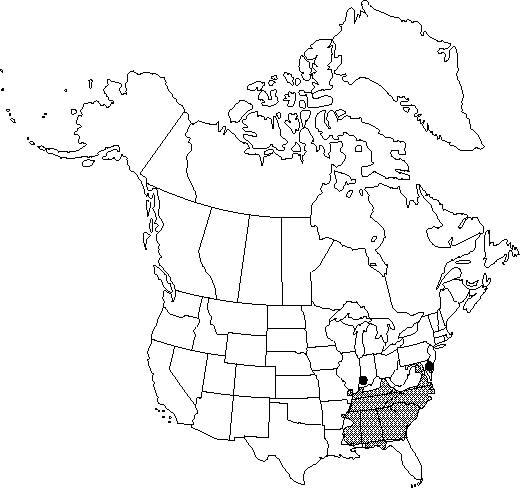Carya pallida
Notizbl. Königl. Bot. Gart. Berlin, App. 9: 19. 1902.
Trees, to 29 m. Bark dark gray, ridged, often deeply furrowed. Twigs reddish-brown, slender, slightly scaly, sometimes pubescent. Terminal buds reddish-brown, ovoid, 4-11 mm, sparsely to densely scaly; outer bud-scales with coarse hairs on midribs, bud-scales imbricate; axillary buds protected by bracteoles fused into hood. Leaves 3-6 dm; petiole 3-10 cm, rachis sparingly hirsute near base, densely hirsute and scaly distally. Leaflets (5-) 7 (-9), lateral petiolules 0-1 mm, terminal petiolules 2-5 mm; blades ovate to obovate or elliptic, not falcate, 2-15 × 1-6 cm, margins finely to coarsely serrate, apex acuminate; surfaces abaxially hirsute toward base of midrib, otherwise without hairs or rarely hirsute with unicellular and 2-8-rayed fasciculate hairs, abundant large peltate scales and small 4-lobed, irregular, and round peltate scales imparting silvery tan color, adaxially glabrous except for dense fasciculate hairs at base near leaf insertions, moderately to densely scaly in spring. Staminate catkins pedunculate, to 13 cm, stalks hirsute, scaly, bracts scaly, hirsute at apex; anthers hirsute. Fruits tan to reddish-brown, obovoid to spheric or ellipsoid, slightly compressed, 3-4 × 2-3 cm; husks rough, 2-4 mm thick, dehiscing to middle or base, sutures smooth; nuts tan, obovoid to spheric or ellipsoid, slightly compressed, not angled, rugulose; shells thick. Seeds sweet.
Phenology: Flowering spring.
Habitat: Well-drained sandy or rocky soils on bluffs, ridges, rolling hills, and dry woods
Elevation: 0-500 m
Distribution

Ala., Ark., Del., Fla., Ga., Ill., Ind., Ky., La., Md., Miss., Mo., N.J., N.C., S.C., Tenn., Va.
Discussion
Carya pallida occurs principally east of the Mississippi River. It seems to intergrade with C. texana in eastern Missouri and southern Illinois, and it may hybridize with C. glabra.
Selected References
None.
Lower Taxa
"dm" is not declared as a valid unit of measurement for this property."broad" is not a number.